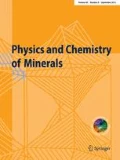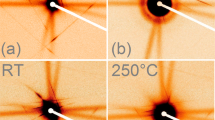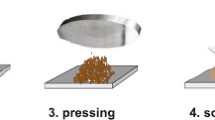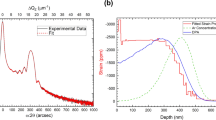Abstract
Static elasticity measurements at high pressures were carried out on oriented fluorapatite single crystals, some of which contained oriented amorphous ion tracks (ITs) implanted with relativistic Au ions (2.2 GeV) from the UNILAC linear accelerator at GSI, Darmstadt. High-pressure experiments on irradiated and non-irradiated crystal sections were carried out in diamond-anvil high-pressure cells under hydrostatic conditions. In situ single-crystal diffraction was performed to determine the high-precision lattice parameters, simultaneously monitoring the widths of X-ray diffraction Bragg peaks. High-pressure Raman spectra were analyzed with respect to the frequency shift and widths of bands, which correspond to the Raman-active vibrational modes of the phosphate tetrahedra. Swift heavy ion irradiation was found to induce anisotropic lattice expansion and tensile strain within the host lattice dependent on the ion-track orientation. The relatively low Grüneisen parameter for the ν 1b(A g) mode, which has been assigned to originate from the volume fraction of the amorphous tracks, and the γ(ν 1a)/γ(ν 1b) ratio reveals compressive strain on the amorphous ITs. The comparative compressibilities for the host lattice reveal approximately equivalent bulk moduli, but significantly different pressure derivatives (K T = 88.4 ± 0.7 GPa, ∂K/∂P = 6.3 ± 0.3 for non-irradiated, K T = 90.0 ± 1.7 GPa, ∂K/∂P = 3.8 ± 0.5 for irradiated samples). The axial compressibility moduli β −1 reveal significant differences, which correlate with the ion-track orientation [\( \beta_{a}^{ - 1} \) = 240 ± 5 GPa, \( \beta_{c}^{ - 1} \) = 361 ± 14 GPa, ∂\( \left( {\beta_{a}^{ - 1} } \right) \)/∂P = 11.3 ± 1.2, ∂\( \left( {\beta_{c}^{ - 1} } \right) \)/∂P = 11.6 ± 3.4 for irradiation ⊥(100); 246 ± 9 GPa, 364 ± 57 GPa, 9.5 ± 2.9, 14.7 ± 14.1 for irradiation ⊥(001), 230.7 ± 3.6 GPa, 373.5 ± 5.1 GPa, 19.2 ± 1.4, 20.1 ± 1.8 for no irradiation]. Line widths of XRD Bragg peaks in irradiated apatites confirm the strain of the host lattice, which appears to decrease with increasing pressure. By contrast, the bandwidths of Raman modes increase with pressure, and this is attributed to increasing strain gradients on the length scale of the short-range order. The investigations reveal considerable deviatoric stress on the [100]-oriented tracks due to the anisotropic elasticity, while the compression is uniform for the directions perpendicular to the tracks, which are aligned parallel to the c-axis. This difference might be considered to control the diffusion properties related to the annealing kinetics and its observed anisotropy, and hence to cause potential pressure effects on track-fading rates.








Similar content being viewed by others
References
Ahrens TJ, Fleischer RL, Price PB, Woods RT (1970) Erasure of fission tracks in glasses and silicates by shock waves. Earth Planet Sci Lett 8:420–426
Anderson OL (1972) Patterns in elastic constants of minerals important to geophysics. In: Robinson EC (ed) Nature of the solid earth. McGraw-Hill, New York, pp 575–613
Angel RJ (2000) Equations of state. High-temperature and high-pressure crystal chemistry. Rev Mineral Geochem 41:35–59
Angel RJ, Allan DR, Miletich R, Finger LW (1997) The se of quartz as an internal pressure standard in high-pressure crystallography. J Appl Crystallogr 30:461–466
Barbarand J, Carter A, Wood I, Hurford T (2003) Compositional and structural control of fission-track annealing in apatite. Chem Geol 198:107–137
Bass JD (1995) Elasticity of minerals, glasses and melts. In: Ahrens TJ (ed) Mineral physics and crystallography. A handbook of physical constants. American Geophysical Union, Washington, DC, pp 45–63
Brunet F, Allan DR, Redfern SAT, Angel RJ, Miletich R, Reichmenn HJ, Sergent J, Hanfland M (1999) Compressibility and thermal expansivity of synthetic apatites, Ca5(PO4)3X, with X = OH, F and Cl. Eur J Mineral 11:1023–1035
Carlson WD, Donelick RA, Ketcham RA (1999) Variability of apatite fission-track annealing kinetics: I. Experimental results. Am Mineral 84:1213–1223
Comodi P, Liu Y, Zanazzi PF, Montagnoli M (2001a) Structural and vibrational behavior of fluorapatite with pressure. Part I: in situ single-crystal X-ray diffraction investigation. Phys Chem Miner 28:219–224
Comodi P, Liu Y, Frezzotti ML (2001b) Structural and vibrational behavior of fluorapatite with pressure. Part II: in situ micro-Raman spectroscopic investigation. Phys Chem Miner 28:225–231
Crowley KD, Cameron M, Schaefer RL (1990) Annealing of etchable fission-track damage in F-, OH-, Cl- and Sr-apatite: 1. Systematics and preliminary interpretations. Nucl Tracks Radiat Meas 17:409–410
Crowley KD, Cameron M, Schaefer RL (1991) Experimental studies of annealing of etched fission tracks in fluorapatite. Gechimica et Cosmica Acta 55: 1449–1465
Dakowski M (1978) Length distribution of fission tracks in thick crystals. Nucl Track Detect 2:181–189
Donelick RA (1991) Crystallographic orientation dependence of mean etchable fission-track length in apatite: an empirical model and experimental observations. Am Mineral 76:83–91
Donelick RA, Roden MK, Mooers JD, Carpenter BS, Miller DS (1990) Etchable length reduction of induced fission tracks in appetite at room temperature (23°C): crystallographic orientation effects and “initial” mean lengths. Nucl Tracks Radiat Meas 17:261–265
Donelick RA, Ketcham RA, Carlson WD (1999) Variability of apatite fission-track annealing kinetics: II. Crystallographic orientation effects. Am Mineral 84:1224–1234
Ferraris C, White TJ, Plévert J, Wegner R (2005) Nanometric modulation in apatite. Phys Chem Miner 32:485–492
Fleet ME, Liu X (2003) Carbonate apatite type A synthesized at high pressures: new space group (P-3) and orientation of channel carbonate ion. J Solid State Chem 174:412–417
Fleischer RL, Price PB, Walker RM (1965) Effects of temperature, pressure and ionization on the formation and stability of fission tracks in minerals and glasses. J Geophys Res 70:1497–1502
Fleischer RL, Woods RT, Hart HR Jr, Price PB, Short NM (1974) Effect of shock on fission track dating of apatite and sphene crystals from the Hardhat and Sedan underground nuclear explosions. J Geophys Res 79:339–342
Gleadow AJW, Duddy IR (1981) A natural long-term track annealing experiment for apatite. Nucl Tracks 5:169–174
Green PF, Durrani SA (1977) Annealing studies of tracks in crystals. Nucl Track Detect 1:33–39
Green PF, Duddy IR, Gleadow AJW, Tingate PR, Laslett GM (1986) Thermal annealing of fission tracks in apatite, 1. A qualitative description. Chem Geol 59:237–253
Hazen RM, Downs RT, Prewitt CT (2000) Principles of comparative crystal chemistry. Rev Mineral Geochem 41:1–34
Jarosewich E, Nelen JA, Norberg JA (1980) Reference samples for electron microprobe analyses. Geostand Newsl 4:257–258
Jaskierowicz G, Dunlop A, Jonckheere R (2004) Track formation in fluorapatite irradiated with energetic cluster ions. Nucl Instrum Methods Phys Res B 222:213–227
King H, Finger LW (1979) Diffracted beam crystal centering and its application to high-pressure crystallography. J Appl Cryst 12: 374–378
Kohn BP, Belton DX, Brown RW, Gleadow AJW, Green PF, Lovering JF (2003) Comment on: “experimental evidence for the pressure dependence of fission track annealing in apatite” by A.S. Wendt et al. [Earth Planet Sci Lett 201 (2002) 593–607]. Earth Planet Sci Lett 215:299–306
Lakatos S, Miller DS (1970) Water pressure effect in fission track annealing in an alpine muscovite. Earth Planet Sci Lett 9:77–81
Lang M (2004) The effect of pressure on ion track formation in minerals. Dissertation, University of Heidelberg
Liu J, Glasmacher UA, Lang M, Trautmann C, Voss K-O, Neumann R, Wagner GA, Miletich R (2008) Raman spectroscopy of apatite irradiated with swift heavy ions with and without simultaneous exertion of high pressure. Appl Phys A 91:17–22
Mao HK, Xu J, Bell PM (1986) Calibration of the ruby pressure gauge to 800 kbar under quasi-hydrostatic conditions. J Geophys Res 91:4673–4676
Matsukage KN, Ono S, Kawamoto T, Kikegawa T (2004) The compressibility of a natural apatite. Phys Chem Miner 31:580–584
Miletich R, Allan DR, Werner FK (2000) High pressure single-crystal techniques. Rev Mineral Geochem 41:445–519
Miro S, Grebille D, Chateigner D, Pelloquin D, Stoquert J-P, Grob J-J, Constantini J-M, Studer F (2005) X-ray diffraction study of damage induced by swift heavy ion irradiation in fluorapatite. Nucl Instrum Methods Phys Res B 227:306–318
Organova NI, Kuz’mina OV, Arapova GA, Litsarev MA, Fin’ko VI, Rastsvetaeva RK (1994) The crystal structure of low-symmetry ellestadite in comparison with other apatite-like structures. Crystallogr Rep 39:234–238
Paul TA, Fitzgerald PG (1992) Transmission electronic microscopic investigation of fission tracks in fluorapatite. Am Mineral 77:336–344
Pouchou JL, Pichoir F (1984) A new model for quantitative X-ray microanalysis, part II: application to in-depth analysis of heterogeneous samples. Rech Aerosp 5:47–65
Pouchou JL, Pichoir F (1985) “PAP” ϕ(ρZ) procedure for improved quantitative microanalysis. In: Armstrong JT (ed) Microbeam analysis. San Francisco Press, San Francisco, pp 104–106
Sha MC, Li Z, Bradt RC (1994) Single-crystal elastic constants of fluorapatite. J Appl Phys 75:7784–7787
Stormer JC, Pierson ML, Tacker RC (1993) Variation of F and Cl X-Ray intensity due to anisotropic diffusion in apatite during electron microprobe analysis. Am Mineral 78:641–648
Vidal O, Wendt AS, Chadderton LT (2003) Further discussion on the pressure dependence of fission track annealing in apatite: reply to the critical comment of Kohn et al. Earth Planet Sci Lett 215:307–316
Wendt AS, Vidal O, Chadderton LT (2002) Experimental evidence for the pressure dependence of fission track annealing in apatite. Earth Planet Sci Lett 201:593–607
Wendt AS, Vidal O, Chadderton LT (2003) The effect of simultaneous temperature, pressure and stress on the experimental annealing of spontaneous fission tracks in apatite: a brief overview. Radiat Meas 36:339–342
Williams Q, Knittle E (1996) Infrared and Raman spectra of Ca5(PO4)3F-Fluorapatite at high pressures: compression-induced changes in phosphate site and Davydov splitting. J Phys Chem Solids 57:417–422
Young EJ, Myers AT, Munson EL, Conklin NM (1969) Mineralogy and geochemistry of fluorapatite from Cerro de Mercado, Durango, Mexico. U.S. Geological Survey Professional Paper 650-D. U.S. Geological Survey, Washington, pp D84–D93
Ziegler JF, Biersack JP, Littmark U (1985) The stopping and range of ions in solids. Pergamon Press, New York
Acknowledgements
We thank Ilona Fin and Oliver Wienand for the careful preparation of the polished crystal sections, Christian Weikusat for his instructions in using the Raman spectrometer and evaluating the spectra as well as for performing the irradiation experiments at GSI, and Hans-Peter Meyer for his help with carrying out the microprobe analyses. Financial support within the BMBF Verbundprojekt (project grant 05KK7VH) is acknowledged. Ulrich A. Glasmacher and Ronald Miletich would like to thank also Rodolfo Corona-Esquivel, Mexico City, for his support during the field trip at Durango. Raman spectra were fitted using the freeware FITYK 0.8.6 (http://www.unipress.waw.pl/fityk/).
Author information
Authors and Affiliations
Corresponding author
Rights and permissions
About this article
Cite this article
Schouwink, P., Miletich, R., Ullrich, A. et al. Ion tracks in apatite at high pressures: the effect of crystallographic track orientation on the elastic properties of fluorapatite under hydrostatic compression. Phys Chem Minerals 37, 371–387 (2010). https://doi.org/10.1007/s00269-009-0340-0
Received:
Accepted:
Published:
Issue Date:
DOI: https://doi.org/10.1007/s00269-009-0340-0




